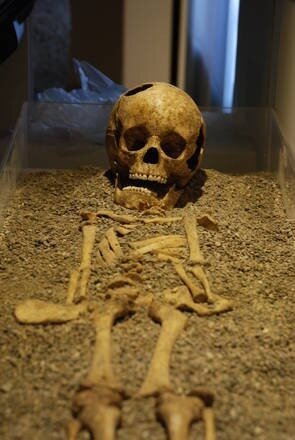
What is this skeleton that has a big hole in the skull, that is also so perfectly preserved? We are in the Museum of the History of Medicine of the University La Sapienza in Rome (which I take the opportunity to advertise, because it is also free), and this is the masterpiece of his collection: the Child of Fidene. Let's discover more about this unusual evidence of our hard past...
This macabre skeleton belongs to a child, but we do not know if male or female, dating back to the II century a.D. This skeleton was found at Fidene, a small town not so far from Rome, that in the past was an area inhabited by some noblemen of the Eternal City and by shepherds and artisans. Probably the child belonged to the family of any freedman who, with the right contacts and investments, he had managed to play a pretty significant role in the peaceful town of Fidene. In this beautiful and, unfortunately, unknown museum was rebuilt the grave, as found by the archaeologists. What immediately catches the eye is, of course, the big hole on the skull. What does it represent? A clear surgery!
Nothing wrong with that, because even today in surgery doctors apply holes cranial to relieve pressure from the brain or for real operations. What is special, however, is that already two thousand years ago, there were attempts in this direction. It is amazing how already in the Rome in the II century a.D., definitely a period of gold for the entire roman civilization, you might be able to get that far. A trepanation of the skull used as a sort of palliative. According to the paleontologists, the skull of the child was larger than normal, and this caused the severe headache or feeling of nausea. Probably the child had a brain tumor, an evil that caused pain. To try to do something, or, more probably, just to give a little serenity to a sick person already sentenced to death from the disease, it was decided to make a very difficult intervention: to remove a part of the skull, so as to reduce the internal pressure to give a little breath to the child. Impressive as, according to the examinations, it is clear that the child has continued to live for another month after the intervention. A new bone material, in fact, was found on the edge of the hole, to indicate how much the baby had, with force, continued to live. Another great surprise, therefore, that leads us to think of how this exhibit is truly unique in its kind.
A cross-section of humanity, but also a way to understand how much he had advanced, in one way or another, the medicine of the time. The poor Child of Fidene, in the Museum of the History of Medicine at the University La Sapienza of Rome, is a symbol of how they could get to operate to the doctors. In fact, it seems that the neurosurgeon in question was able to remove the section of the skull in the absolute quietness, with a firm and secure hand. It is also probable that it was not of course the surgery to kill the child, indeed! There are no signs of physical stress as a result of the drilling as it is, instead, many are the signals highlighted by palaeontologists that indicate how many infections hit the body of the child, as a result of the intervention. Despite the wound had been bandaged, probably, the Child of the Fidene, died for complications following the operation, not so much for the disease itself. And in spite of the care of competent doctors, unfortunately, death came anyway.

